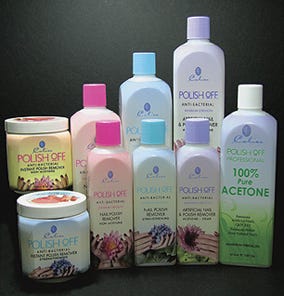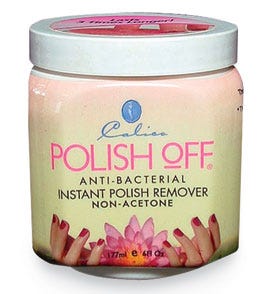March 11, 2015
 Calico Laboratories, Inc., a Festus, MO-based manufacturer of brand-name and private-label nailcare products, has been brushing up the look of its nail polish remover packaging with a move to full-body shrink-sleeve labels. Available in various mass-merchandise, grocery and drugstores around the country, such as Wal-Mart, Eckerd Drugs, Fred Meyer, RiteAid and Meijer, the polish removers include Calico's Polish Off Anti-Bacterial brand, a product notable for its antibacterial properties and choice of formulation strengths. The nail polish remover category is virtually flooded with products, including many private-label brands, and offers various formulations, benefits and packaging with assorted dispensing choices, container shapes and labeling—all paramount to sales success. Calico says it needed a unique look to set the Polish Off line apart from the competition.
Calico Laboratories, Inc., a Festus, MO-based manufacturer of brand-name and private-label nailcare products, has been brushing up the look of its nail polish remover packaging with a move to full-body shrink-sleeve labels. Available in various mass-merchandise, grocery and drugstores around the country, such as Wal-Mart, Eckerd Drugs, Fred Meyer, RiteAid and Meijer, the polish removers include Calico's Polish Off Anti-Bacterial brand, a product notable for its antibacterial properties and choice of formulation strengths. The nail polish remover category is virtually flooded with products, including many private-label brands, and offers various formulations, benefits and packaging with assorted dispensing choices, container shapes and labeling—all paramount to sales success. Calico says it needed a unique look to set the Polish Off line apart from the competition.
Says Calico's vp Traci Palmero, "Retailers are extremely happy with the new packaging because it's like nothing else in the category. The improved appearance of our bottles and jars has helped retailers increase sales."
Prior to installing the EZ-Seal 200HS sleeve-label applicator from Axon Corp., Calico was applying front-and-back labels to its high-density polyethylene bottles and jars. The full-body shrink-wrapped sleeves not only improve the product's appearance, it reports, but allow it to promote the products effectively on four container sides instead of just two.
In March 2006, Calico installed the EZ-Seal 200HS system to work with nail polish remover in 4-, 8-and 16-oz bottles and 6-oz jars and uses it to label 25 to 30 percent of the Polish Off Anti-Bacterial line. The company says it will also soon begin using the system in its contract-packaging activities. The oriented polystyrene shrink film, from New Century Packaging Systems, is impervious to acetone—the primary ingredient in most polish removers and one that Calico uses to produce a polish-removal formulation in a 100-percent strength.
 The natural-tone bottles and jars, which Calico injection- and extrusion/blow-molds in-house at a second facility, now wear full-body shrink sleeves decorated with inviting graphics. Designed to appeal to women, the color schemes in soft pastels graduate from dark to light and are color-coded according to product variety.
The natural-tone bottles and jars, which Calico injection- and extrusion/blow-molds in-house at a second facility, now wear full-body shrink sleeves decorated with inviting graphics. Designed to appeal to women, the color schemes in soft pastels graduate from dark to light and are color-coded according to product variety.
Featuring tool-less changeovers, the 200HS sleeve labeler has an advanced film-delivery system designed to accommodate various container shapes. "Our labels have a high level of graphic content, such as illustrations of hands and flowers that need to be color-correct," explains Palmero. "We chose the gravure-printing process for all of our labels. The sleeve-applicating machine has a photoeye that reads and cuts off the label to the correct length."
Axon designed the EZ-Seal 200HS to handle both full-body shrink sleeves and tamper-evident bands in widths from 1 1/4 to 4 3/4 in. at speeds in the 120-packages/min range—well within Calico's line-speed range of 32 to 44 bottles/min, depending on container size. The 6-oz jars run at about 40/min.
Both Jel Sert and Noga Dairy opted for shrink labels for their new, cool drink bottles. Read more at www.packagingdigest.com/info/jelnoga
The dual-head sleeve applicator and a Model EZ-72-SS steam tunnel, also provided by Axon, were flexible enough to fit within the line, which also runs assorted products that require front-and-back labels. Calico redesigned the flow of the line so that the front/back labeler can be bypassed when containers need to be sleeve-labeled and vice-versa.
 Label/sleeve application is the final step in the production process on the filling line, Palmero says. After the containers are filled and capped, they progress to the labeling/sleeving station where the EZ-Seal applicating machine has two delivery heads that cut and apply two labels at a time. First, as the film unwinds and travels through the machine, which is powered by a stepper drive system, it's fed through a fiberoptic print-registration syste that triggers the stepper drive to stop the film feed at the correct time. The film passes over a film-bullet forming device and feeds through a knife block as opposing film grippers come together and vacuum is applied to secure the label onto the container. The film is then cut via a guillotine knife and the grippers open the label. The label is then pushed by a plunger onto the container entering the label-application zone and the whole process is repeated. The container then moves to the steam tunnel, which heats the sleeve to snugly conform it to the container.
Label/sleeve application is the final step in the production process on the filling line, Palmero says. After the containers are filled and capped, they progress to the labeling/sleeving station where the EZ-Seal applicating machine has two delivery heads that cut and apply two labels at a time. First, as the film unwinds and travels through the machine, which is powered by a stepper drive system, it's fed through a fiberoptic print-registration syste that triggers the stepper drive to stop the film feed at the correct time. The film passes over a film-bullet forming device and feeds through a knife block as opposing film grippers come together and vacuum is applied to secure the label onto the container. The film is then cut via a guillotine knife and the grippers open the label. The label is then pushed by a plunger onto the container entering the label-application zone and the whole process is repeated. The container then moves to the steam tunnel, which heats the sleeve to snugly conform it to the container.
The sleeve labels have not only increased sales, but provided very accurate shrink application, Palmero points out. "That means our [increased] output stems from correct sleeve placement every time," she notes. The plant likes the machine's speedy changeovers in container size and label graphic formaty," she adds. "We can run artwork for three different [stockkeeping units] on an eight-ounce container and artwork for two sixteen-ounce bottles immediately afterward, in the same eight-hour shift. Any further line extensions would be considered for the shrink-label application," Palmero explains.
Calico's successful project proves that it's usually a wise decision to polish up the look of your packaging. "We're very pleased," Palmero sums up, adding, "We welcome any filling business that requires a shrink-label. We wanted to provide this decorating option to our customers."
More information is available:
Axon Corp., a div. of Pro Mach, 919/772-8383. www.axoncorp.com
New Century Packaging Systems, 636/537-9590. www.newcenturypkg.net .
You May Also Like


